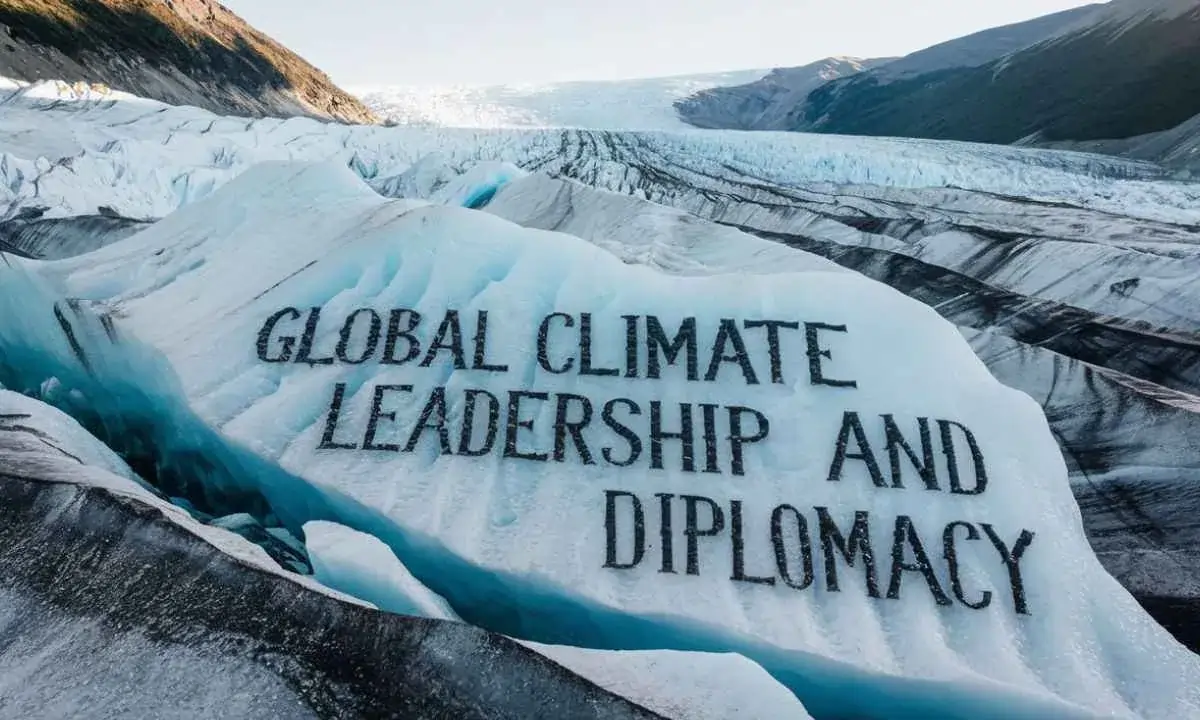Global Climate Leadership and Diplomacy

Global climate leadership and diplomacy, in the general sense, is the sum of actions, policies, and plans used by world countries, international organizations, and other environmental and policy groups to handle the effects of climate change around the world.
What this means is creating rules and regulations, signing multilateral agreements, and leading global, national, and local projects to reduce greenhouse gas emissions, adapt to climate change, and support sustainable development.
Climate diplomacy generally refers to using diplomatic tools to support the achievement of international climate goals and mitigate the negative impacts of climate change on peace, stability, and prosperity.
Climate action in relations with partners worldwide, shaping foreign policy agendas, and building partnerships that tackle climate and other foreign policy objectives, such as peacebuilding or strengthening multilateralism.
Climate Change is one of the greatest challenges of the modern world. The average temperature of the world is on a steep rise. Environmental movements have surged, urging the international community to take urgent and decisive action.
The global climate system has varied greatly throughout the history of Earth. However, in the final decades of the 20th century and at the start of this new century, Earth has experienced an unprecedented rate of warming.
Rising average global temperature has resulted in rises in ocean temperature and sea levels, shrinkage in ice sheets and glacier covers, increase in the frequency and intensity of weather patterns, impacts on eco-systems, food and water security, coastal regions and human health, and nature’s biodiversity.
The consequences of the foreign policy agenda of developed and developing countries are significant. A strengthened role of the global political agenda in international climate policy is the need of the hour.
If greenhouse gas emissions continue to be high, most countries around the world will find it extremely hard to adapt to human-induced components of global warming and climate change.
"The climate crisis can only be overcome through cooperation – between peoples, cultures, nations, generations."
UN Secretary-General António Guterres
The 2018 EU Parliament resolution on climate diplomacy states “It’s a form of targeted foreign policy to promote climate action through reaching out to other actors, cooperating on specific climate-related issues, building strategic partnerships, and strengthening relations between state and non-state actors, including major contributors to global pollution, thereby contributing to mitigating the effects of climate change, as well as to enhancing climate action and strengthening Union’s diplomatic relationships”.
The European Commission defines four strands of climate diplomacy at the political level:
- Committing to multilateralism in climate policy, particularly to the implementation of the Paris Agreement
- Addressing implications of climate change on peace and security
- Accelerating domestic action and raising global ambition
- Enhancing international climate cooperation through advocacy and outreach.
Key Components of Global Climate Leadership and Diplomacy:
International Agreements and Treaties
International agreements, protocols, targets, and treaties play a crucial role in fostering global collaboration and commitment to addressing global climate change concerns. These provide a framework of action for nations to unite in their efforts and achieve collective environmental goals collectively.
United Nations Framework Convention on Climate Change (UNFCCC):
Also known as the Climate Change Convention, UNFCCC is the foundational treaty negotiated at the UN Earth Summit in 1992 to stabilize greenhouse gas concentrations in the atmosphere at a level that would prevent adverse anthropogenic interferences with the global climate systems.
It entered into force on 21st March 1994. The convention is non-binding in the sense that it didn’t set any binding limits on Greenhouse gas emissions for signed countries.
Kyoto Protocol:
The protocol was adopted to have a legally binding obligation to set binding limits on GHG emissions. It is an international agreement under the UNFCCC, negotiated in 1997, that sets binding emission reduction targets for developed countries.
It also brought to the table flexible mechanisms, Emissions Trading, Joint Implementation (JI), and Clean Development Mechanism.
Paris Agreement:
A landmark international accord adopted in 2015, where countries committed to limiting global warming to well below 2 degrees Celsius above pre-industrial levels, with efforts to limit the increase to 1.5 degrees Celsius.
The pact also provides a pathway for the world’s developed countries to assist the developing countries in their mitigation and adaptation efforts in the face of climate change.
The agreement has seen commitments from 197 nations.
The agreement went into force on November 4, 2016, when it reached its goal of being represented by 55 nations with at least 55% of global emissions formally joining.
As of September 2019, only 7 countries were compliant with the Paris Climate Agreement.
| Agreement | Year | Key Features | Outcomes |
|---|---|---|---|
| UNFCCC | 1992 | Set framework for global action to stabilize greenhouse gases. | Basis for all future climate negotiations; became active in 1994. |
| Kyoto Protocol | 1997 | Legally required emissions cuts for developed nations with flexibility mechanisms. | Took effect in 2005, extended until 2020; focused on developed countries. |
| Copenhagen Accord | 2009 | Non-binding pledge to limit warming to below 2°C. | Marked shift to voluntary climate pledges by countries. |
| Cancún Agreements | 2010 | Set the 2°C target and created the Green Climate Fund for helping poorer nations. | Reinforced global commitments on finance and emissions targets. |
| Durban Platform | 2011 | Called for a new global climate deal involving all countries. | Led to negotiations for the Paris Agreement. |
| Paris Agreement | 2015 | Aimed to limit warming to 1.5°C and required countries to submit climate action plans (NDCs). | Became active in 2016, with 197 nations signing on. |
| Katowice Package | 2018 | Developed rules to monitor and report climate efforts under Paris Agreement. | Created transparent guidelines for tracking climate progress. |
| Glasgow Climate Pact | 2021 | Focused on faster emissions reductions and coal phase-out by 2030. | Acknowledged that more needs to be done to meet the 1.5°C target. |
| COP27 Sharm el-Sheikh Plan | 2022 | Established funding for climate damage and adaptation in vulnerable nations. | Recognized the need for financial support to those most affected by climate change. |
Climate Negotiations
Conference of the Parties (COP):
The supreme decision-making body of the UNFCCC, which meets annually, since 1995, to assess progress and negotiate new commitments. The 21st COP (COP 21) saw the landmark agreement The Paris Agreement being negotiated and coming into force to combat GHG emissions.
Also Read: COP29: What’s Next for Global Climate Policy?
Intergovernmental Panel on Climate Change (IPCC):
Provides scientific assessments on climate change to inform policy decisions. It’s the United Nations body that assesses the science behind climate change and provides policymakers with regular scientific assessments on climate change, its implications, and potential future risks, as well as to put forward adaptation and mitigation options.
“Human activities, principally through emissions of greenhouse gases, have unequivocally caused global warming, with global surface temperature reaching 1.1°C above 1850-1900 in 2011-2020.”
IPCC, 2023: Summary for Policymakers. In: Climate Change 2023
National Commitments and Policies
Nationally Determined Contributions (NDCs):
According to UN “An NDC is a climate action plan to cut emissions and adapt to climate impacts. Each Party to the Paris Agreement is required to establish an NDC and update it every five years”.
The Paris Agreement (Article 4, paragraph 2) requires each Party to prepare, communicate, and maintain the NDCs they aim to achieve.
Financial Mechanisms
Climate Finance:
Financial flows from developed to developing countries to support climate mitigation and adaptation activities.
Leaders in climate finance include the World Bank, Green Climate Fund, Asian Development Bank, African Development Bank, and European Investment Bank, which fund projects to combat climate change.
Major companies like BlackRock and HSBC invest in green energy and sustainable finance.
Governments like the European Union (EU) and China lead in green policies, while philanthropies like the Rockefeller Foundation and the Gates Foundation support climate-related projects.
Green Climate Fund (GCF):
A global fund established to support developing countries in their efforts to combat climate change by financing projects that reduce emissions and enhance resilience.
The Green Climate Fund (GCF) helps fight climate change by funding low-emission and climate-resilient projects.
Established in 2010 by 194 countries under the UN Framework Convention on Climate Change, it supports developing countries, especially those most vulnerable like Least Developed Countries (LDCs), Small Island Developing States (SIDS), and African nations.
The GCF is managed by a 24-member board and is headquartered in South Korea.
Multilateral and Bilateral Cooperation
Partnerships and Alliances: Countries, regions, and organizations working together to share knowledge, technology, and resources in the fight against climate change effects.
Bilateral Agreements: Agreements between two countries to work together on climate and GHG emission reduction projects.
Non-State Actors
Companies and industries committing to reducing their carbon footprint and investing in sustainable practices. NGOs, advocacy groups, and community organizations playing their role.
Model cities around the world and local authorities can set examples in their efforts to mitigate and adapt to climate change consequences.

Challenges in Global Climate Leadership and Diplomacy:
Some of the most common challenges faced in global climate agenda are:
Differing National Interests:
Countries have different economic priorities and levels of development, which affect how they approach climate commitments. To achieve economic growth and lift their population out of poverty, developing nations would prefer to continue use of fossil fuels as means of energy production.
Developed industrialized nations, who are responsible for historical greenhouse gas emissions, are looking to transit to low-carbon economies. However, it is going to be a slow transition process which means they will continue to emit large amounts of greenhouse gases for the time being.
Equity and Climate Justice:
It’s important to balance the responsibilities of developed and developing countries, considering past emissions and current abilities.
Disparity in interests between countries could lead to different voices in global climate negotiations.
Marginalized communities, indigenous localities, women, children and poor are more severely affected by the consequences of climate change and rise in average global temperature.
Therefore, principles of equity, fairness and justice in climate actions are needed from global climate leadership and diplomacy to foster international sustainable growth and build trust among all parties involved.
Compliance and Accountability:
Countries must be held accountable for meeting their climate commitments and implementing effective policies. This would include accountability for both developed and developing nations of the world.
Scientific Uncertainty and Communication:
There’s a need to address uncertainties in climate predictions and communicate the urgency of action clearly to the public and policymakers.
The scientific community should be provided a unchallenged voice at environmental policy making.
Financial and Technological Transfer:
This is needed to bridge the gap that exists between developed and developing countries in the collective fight against climate change.
There is lack of resources, expertise and modern technology in developing countries hindering the process of transition to low-carbon production and consumption patterns and achieving climate-resilience.
Reducing Fossil Fuel Dependence in Energy Transition:
One of the key component of global climate change mitigation strategies is the global energy transition from fossil fuels to renewable and sustainable energy sources.
To achieve the targets of Paris Agreement, all countries needs to reduce their reliance on fossil fuels for energy demands.
Importance of Global Climate Leadership
Global climate leadership helps nations work together to:
Climate diplomacy has shifted from being event-driven to an ongoing effort, with the EU taking a leading role in global platforms like the G7, G20, and World Economic Forum.
The EU is also focusing on building strong international partnerships, such as its Green Alliance with Japan and the energy transition deal with South Africa.
Current Global Climate Efforts
In 2015, the Paris Agreement set a goal to limit global warming to 1.5°C above pre-industrial levels. However, a 2023 report from the United Nations Intergovernmental Panel on Climate Change (IPCC) warned that we could exceed this target within a decade.
Despite this, there’s still a small, yet achievable, path forward. To stay under the threshold, global greenhouse gas emissions need to be cut by 60% by 2035.
Climate Targets and Challenges
Following the 2021 COP26 in Glasgow, 65% of the world’s largest economies committed to 1.5°C climate targets.
The International Energy Agency (IEA) stated that if these promises were fully implemented, global warming could be limited to 1.7°C. Yet, progress has been slow, with fossil fuel emissions rising by 1% between 2021 and 2022.
Implementation remains a challenge.

The actions of major emitters like the United States, India, and China are crucial in shaping the global impact of climate change and altering geopolitical dynamics.
Despite these agreements, global CO2 levels continue to rise.
The latest UN Climate Summit found that more action is needed from all nations to prevent temperatures from increasing by 1.5°C
Climate Diplomacy: Reasons for Optimism and Future Outlook
Despite these hurdles, there are positive steps. The U.S. Inflation Reduction Act and the EU’s plan aim to significantly reduce emissions by 2030.
Additionally, the Global Methane Pledge, aimed at reducing methane emissions by 30% by 2030, now includes 150 countries. Falling costs in renewable energy and new technologies also offer hope for the future.
There are several hopeful signs in the fight against climate change: solar energy is now the cheapest power source, electric cars are becoming reliable sources of transportation, large batteries are storing renewable energy, courts are holding fossil fuel companies accountable, and global agreements are moving towards sustainable energy use.
There is broad agreement among scientists on the basics of climate change that human activities are driving climate change.
If global temperatures rise by 1.5°C, we face severe impacts such as more intense heatwaves, extreme weather, rising sea levels, and loss of biodiversity.
Climate diplomacy is crucial because the complex challenges of climate change at a global scale can only be addressed through international partnerships, collaboration, and cooperation. Climate diplomats facilitate this by creating an atmosphere conducive to collective efforts, actions, and shared responsibility in combating climate change.






